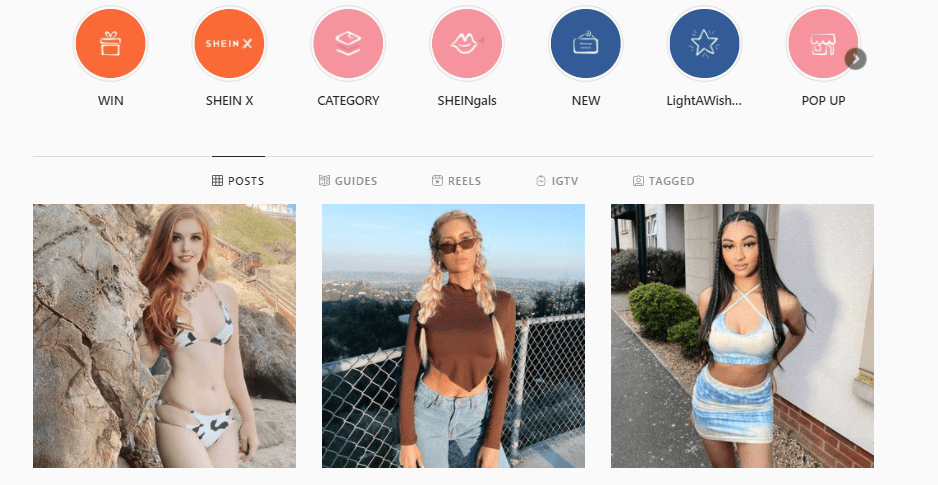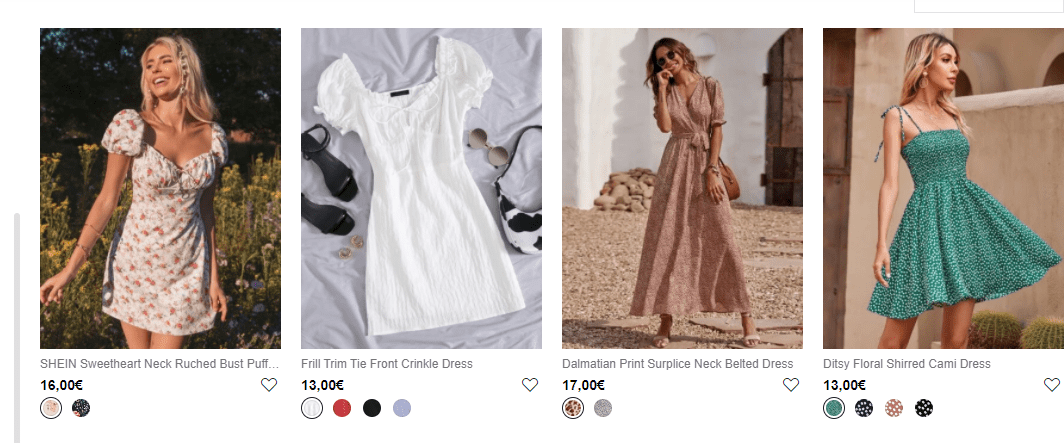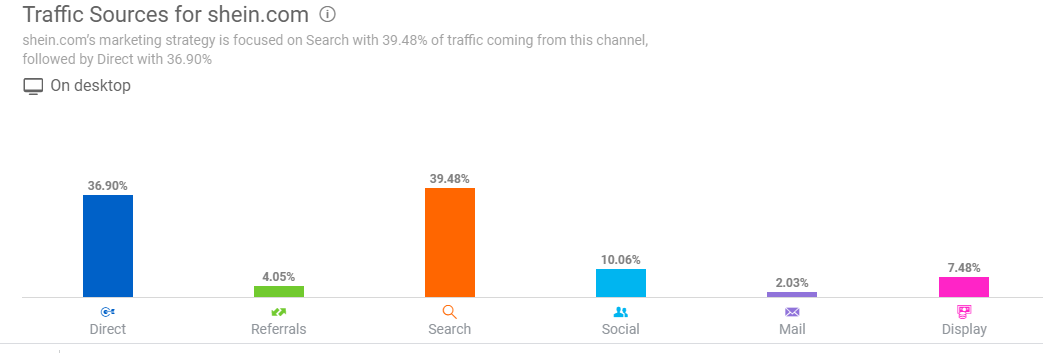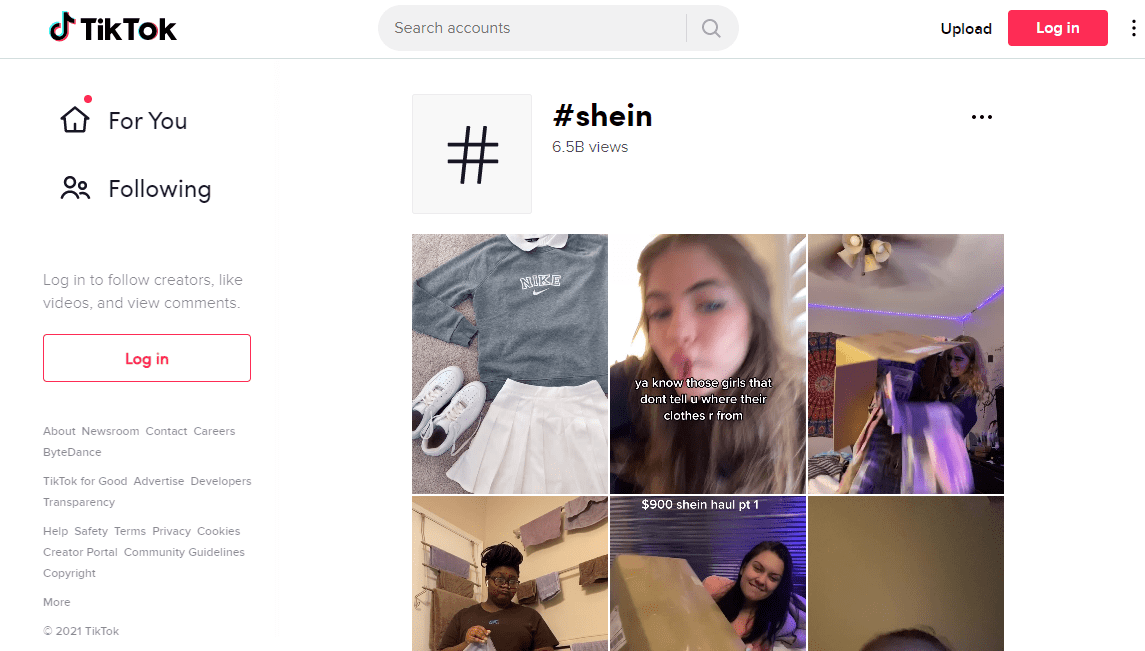Shein is now the largest cross-border fast fashion e-commerce company in China. The e-commerce clothing brand reaches the consumer markets in the United States, France, Russia, Germany and over 200 other countries. According to Airnow Data, in 2021 Shein’s mobile app has exceeded 7 million active users a month in the US alone. According to Jing Daily, on TikTok, the hashtag #Shein has garnered over 6.2 billion views.
To westerners, it seems the craze for Shein has exploded out of nowhere. But this type of explosive growth is increasingly common among new Chinese companies which put revenue and growth before profits. Shein is using many market strategies that work in China in the west.

Data Source: Airnow, Shein MAU in the US
What is Shein?
Shein is a Chinese online clothing and accessories online store founded in 2008. However, only in recent years it has become popular in the West. It features clothes for women for all occasions and in all sizes, including a huge collection of stylish Plus Size models that are still rare on the market. In addition, there are categories for men and children, as well as a new section with a tiny gadgets and home decorations.
The success of Shein in the West
In 2020 Shein announced that sales have exceeded 40 billion yuan, and they will hit 100 billion in 2021. Google statistics shows that users search for it three times more than some western brands like Zara. In 2020 Shein launched 150,000 new items throughout the year, with an average of more than 10,000 new items per month. It has caught up with Zara’s annual new product volume in just one to two months, and the speed is still accelerating. In March 2021, Shein’s women’s clothing category alone had an average of 2,000 new products per day.
What makes Shein’s market strategy in the west different?
Although such fast fashion brands like Zara are not expensive – a small dress may cost more than 30 dollars, while a similar dress on Shein costs half that price. The styles of Shein’s clothes are more diverse, and the colors and patterns are more varied. “Sexy” is a key clothing style on Shein.

Source: Shein Instagram page, as a part of Shein’s market strategy, they sell sexy and casual clothes for very cheap
Its model image is also close to Instagram and Weibo internet celebrities, rather than Zara’s traditional fashion sense.
Middle East is an important region for Shein
Shein entered the Middle East in 2016, and its sales in the Middle East reached 200 million yuan that year. At present, Shein has ranked among the top ten shopping apps in the two main markets in the Middle East: UAE and Saudi Arabia.
Why western gen z consumers prefer Shein over Amazon to buy clothes
Amazon for Western people is what Taobao and Tmall are for Chinese. Over the years, Amazon has firmly occupied the top list of shopping sites visited by the American public. However, in 2020, Shein was the most popular online clothes store in a survey of 9,800 American teenagers with an average age of 15.8 years and an average family income of US$67,500.
More young consumers are beginning to marvel at the low prices of SHEIN. For example, the price of a women’s T-shirt can be as low as 6 US dollars, and the price of a dress can be as low as 12 US dollars.

Source: Shein assortment of clothing, dresses at a price point beating any fast-fashion brand
How Shein became popular in the West?
One of the strategies of Shein is that it chooses less popular influencers in the West, rather than a more costly one. They post on Instagram, YouTube or TikTok and get free products delivered every month. Some of them can also get 10% to 20% commission from Shein’s referral sales.
Referral is indeed effective, as it helps to spread the awareness about the brand. According to SimilarWeb‘s traffic source statistics for the Shein.com site, in March 2021, 14% of the traffic can be directly traced to influencer recommendations (social and referrals), and 39% of the traffic comes from organic search. However, the proportion of direct access traffic exceeds 30%, which indicates a high proportion of returning customers.

Data Source: SimilarWeb, Shein traffic sources
Shein’s market strategy: Products and brands
The Shein site contains exclusive items selected by Shein stylists and created by designers specifically for the online store, as well as clothes, shoes and accessories from brand partners. The catalog has convenient navigation for buyers. All products are divided into categories: Men, Women and Children; standard sizes and models Size +; seasonal collections; promotions and sales; fashion trends and style directions.
Shein has an incredibly wide range of products which makes shopping online fun. Consumers never know what they will encounter in the store, and each day the selections are different. For young, price-oriented consumers do not require a long-lasting professional wadrobe, Shein’s product selection is perfect.
Shein’s market strategy: Hitting the target audience of gen z
Its target audience is price-driven people who love online shopping from all over the world. The most common purchases on the website are from:
- Gen Z consumers, mostly women
- Parents of children from 1 to 15 years old
Gen Z is the most important consumer group for Shein. Accordingly, Shein’s market strategy targets mostly young people. They have a desire to be both unique and socially acceptable. This demographic generation represents a significant sector of the market, but requires new marketing strategies.
Young people today do not respond to the same tricks as the generations of their parents. For instance, 55% of Gen Z cite price as the most important factor when shopping for fashion. Shein has a wide and fragmented channel mix of website, app, social media and a wide network of fashion influencers. Generation Z relies more on social media and targeted mobile advertising to discover fashion brands more than other generations. Moreover, Shein’s Instagram promotes body positivity and self-love. For young consumers, this is also key
Shein also collaborates with the Western celebrities who are popular among young people. For example, Katy Perry, Lil Nas X, Rita Ora, Hailey Bieber represented Shein in 2020.
Shein’s marketing strategy on Tiktok

Source: TikTok, Shein hashtag search results
Shein is the #1 brand for Tiktok teens. Shopping is driven by a constant stream of coupons and discount codes. Tiktok users appreciate the large selection of sizes and inclusivity. For example, Shein is available in sizes XL to 4XL. On TikTok, Shein has created armies of fashion bloggers supporting the brand and making posts with hashtag Shein. Influencers get free merchandise every month for their posts on TikTok. Others earn commissions on sales directed to Shein.com, above the average affiliate rates.
Shein’s marketing strategy on YouTube
Like Primark, Shein has created the environment for shoppers to feel smart and savvy to find the perfect outfit in style. The sheer range of items sold through the store and the fact that not everything is always in stock create an almost gamified experience. Customers are filming videos of how they found inexpensive goods. They are happy to unpack their clothes and try it on. Sometimes these products may not be the right size or look cheaper than they are on the Internet, but this risk adds to the fun.
Shein’s marketing strategy: Affiliate program for influencers
Since Shein is a standalone brand and not a platform for sellers like Amazon, your chance to be part of Shein is the affiliate program.
In affiliate programs, you will earn commission on all recommended sales simply by referring customers to Shein.com. You can choose between Shein Official Affiliate and Partner Affiliate Platforms.
How influencers earn money from Shein
- They promote SHEIN on social media.
- A prospect clicks on the posts
- The client places an order
- The influencers receive commissions
Shein’s secret to success: Understanding the psychology of a new generation
The online apparel market is changing rapidly and strategies must be constantly updated to beat competitors. Shein’s success demonstrates that its marketing strategy based on a sincere understanding of the new generation works well.
Shein also beats its competitors with fast delivery and cheap prices. The company is becoming more and more vertically integrated with leading in-house developments. Average delivery time is 6-8 days. Processing usually takes 1-3 business days. It is also possible to choose premium delivery and receive the goods in 2-4 days.
Moreover, Shein actively supports an active community of like-minded shoppers through its channels. Their website and mobile stores include extensive expert reviews as well as a style gallery through which shoppers can share their clothes and tag products with their style sources.
Netizen criticism of Shein
However, Shein is also facing criticism from consumers. Lots of other customers have warned of frustration on the forums. For example, in Trust Pilot, 43% of people rate a brand as “bad”. In addition, there are many YouTube videos showing Shein’s clothes come in the wrong size or fit differently from the photos.
China market tactics that Shein applied in the west
As a Chinese company that has become wildly popular around the world, it’s no surprise that some Chinese market strategies have seeped into Shein’s global strategy. In a way, Shein tested the waters for Chinese brands looking to expand abroad, to see what market strategies they can take abroad, and what won’t work. Here’s a look at what Shein market strategies worked and don’t work in the west.
What works:
- Micro-influencer marketing. Shein’s influencer marketing strategy is similar to KOC marketing in China.
- Pricing. Shein’s pricing matches that of Taobao, which is lower than other fast fashion but is not available outside of China. Because of the price, Shein was able to expand quickly, making a large amount of each item, which thereby allows the brand to produce in bulk and even further lower costs.
- Discounts. Similar to many Chinese brands in the domestic market, Shein frequently offers discounts. Discount for purchasing through an influencer, discount for downloading the app, and a portion of their website that offers rotating sales.
What sort of works:
- Body positivity. there is still dedicated sections for plus sized clothes, and the brand has taken a stance on body positivity. However, at a time when many western apparel brands are pledging to stop photoshopping models, Shein is using overly photoshopped images to fit unrealistic beauty standards.

Source: Screenshot posted by Reddit user, a Shein model with clearly photo shopped features.
- Social responsibility. Shein has a clear social responsibility statement on their website, stating that they do not use child labor. However, many consumer still feel the brand is not being transparent as to from where production is outsourced. The lack of transparency undermines their social responsibility statement.
What does not work:
- Lack of cultural sensitivity. “Politically correct” means something else in the west than it does in China, and in the west, cultural appropriation belongs in the “politically incorrect” category. One major slip-up Shein made on this front was appropriating Muslim prayer mats to be ‘rugs’, which got backlash. On another note, Shein sold the Buddhist swastika sign on jewelry, however in western cultures, the swastika is more closely related to anti-Semitism. Although the jewelry piece was made in the design of the Buddhist swastika, consumers can’t help but relate the symbol to the Nazi swastika.
- Too many ads and notifications. A common complaint of Shein is that it sends to many notifications, and has too many ads within the app. This is a cultural difference between internet usage in the west vs. China – while Chinese prefer website that are busier and are less bothered by notifications, westerners like clean-cut and simple websites like Google, and prefer less notifications and ads.
